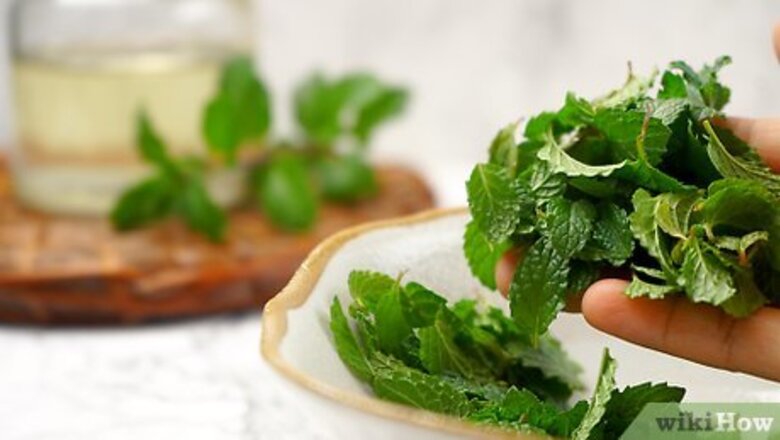
views
X
Research source
Making your own peppermint oil at home is really simple. You basically just need peppermint leaves, olive oil (or a similar oil) and a jar. That’s it! Pretty soon you’ll have some homemade peppermint oil that will last you for months.
Washing and Drying the Peppermint
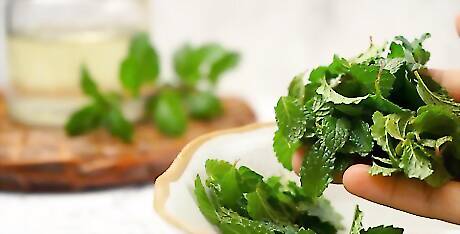
Gather enough peppermint leaves to produce the desired amount of oil. Ideally, the peppermint should come fresh from your garden or a similar source. If that’s not an option, it’s perfectly fine to pick up a bundle or two at the store. Use only the broad, green leaves. Taking the stems from a peppermint plant could cause it to die. Unlike other types of essential oils, peppermint oil is technically an infusion. This means that the amount of carrier oil you use to steep your leaves will determine how much you ultimately end up with.Tip: If you’re picking your own peppermint, the best time to harvest the leaves is just before they begin to flower. This is when they’ll be most potent.
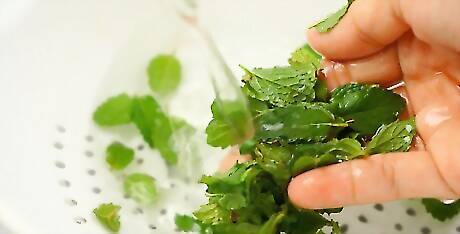
Wash your peppermint thoroughly with cool, clean water. Place the leaves in a colander or mesh strainer and run a stream of water over them to rinse away dust, dirt, and debris. For a more thorough clean, you can also soak your peppermint in a shallow bowl for 5-10 minutes. Inspect your peppermint leaves while you’re washing them and throw out any that look diseased, damaged, or discolored. Giving your peppermint a good preliminary rinsing helps ensure that no foreign substances end up in your finished oil.
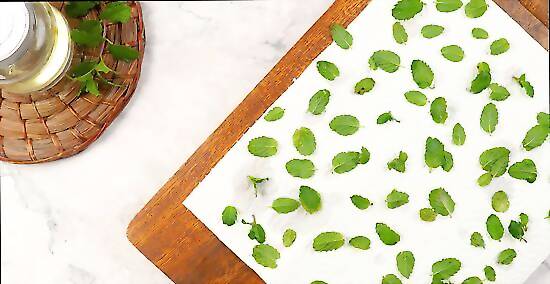
Allow your peppermint leaves to air dry thoroughly. Shake the leaves gently to remove excess water, then arrange them in a single layer on a countertop, cutting board, or similar surface. If necessary, smooth the leaves with the pad of your finger to keep them from folding or curling as they dry. You could also set your still-wet peppermint leaves on a clean towel or layer of folded paper towels to soak up more moisture. Your peppermint leaves need to be completely dry before you begin the oil extraction process.
Making the Essential Oil
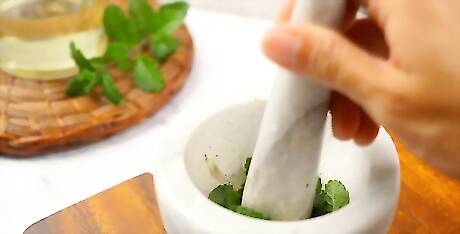
Muddle the peppermint leaves gently with a heavy, blunt object. Use a mortar and pestle, mallet, or the back of a spoon to crush the leaves against a hard, solid surface. Move your utensil using delicate strokes and apply light, even pressure. If you prefer, you can also simply tear and squeeze your peppermint leaves by hand. Muddling causes plants to release their natural oils, and is one of the most important steps in making various essential oils at home. Be careful not to grind the leaves too much, as this can cause them to become bitter and make them harder to strain later on. You just want to unlock their aromatic essence, not mangle them.
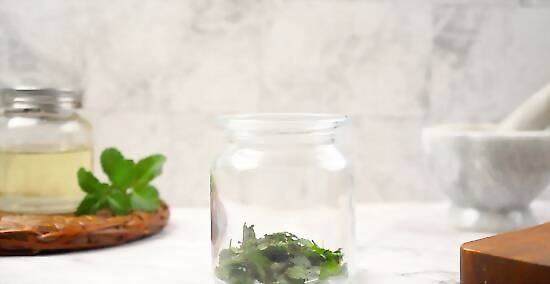
Transfer the crushed leaves to a jar or similar container. Scoop up the leaves and place them at the bottom of your container. Add as many leaves to the container as you can fit, but be sure to leave enough room at the top for its contents to move around a little. It’s crucial that you select a container with a lid that forms an airtight seal, as exposure to air can cause plant oils to spoil. A container made from glass or ceramic will work best, as you won’t have to worry about these materials contaminating your oil the way you would with plastic or metal.
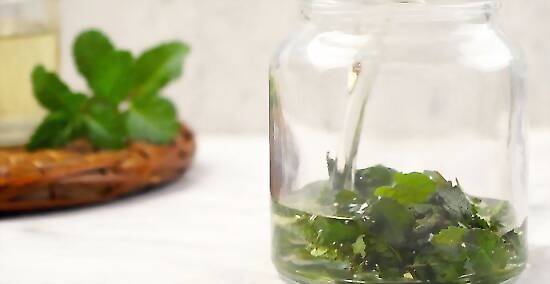
Cover the leaves with a mild, unscented carrier oil. Pour in just enough oil to leave the peppermint completely submerged. When you’re done, give the jar a shake to swirl the leaves around and help them become better incorporated into the carrier oil. Keep in mind that too high a ratio of carrier oil to peppermint will lower the concentration of your finished oil.Tip: Olive, grapeseed, almond, and wheat germ oil are all mild oil varieties that are well-suited for preparing essential oils at home.
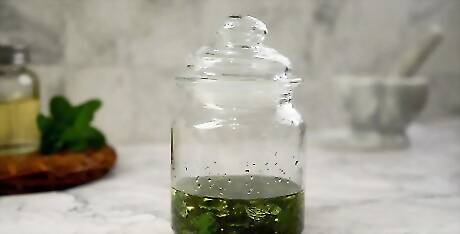
Leave the jar to sit in a warm, dark place for 24-48 hours. Seal the jar up tight and situate it in a corner of your kitchen, pantry, bathroom, or porch. Any area will work as long as it’s not overly hot or cool. For this reason, it’s also a good idea to keep your oil out of direct sunlight. If you live in a colder climate, place your jar near a heat source or inside an insulated cabinet to keep it at the optimum temperature. Warmer temperatures will encourage more of the oil in the peppermint leaves to escape.
Straining and Concentrating the Oil
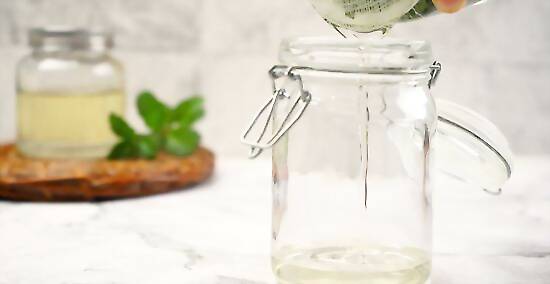
Strain the infused oil through a piece of cheesecloth. After letting your peppermint steep overnight, remove the lid from the jar and drape the cheesecloth over the opening. Tilt the jar over a second container so that the oil flows out through the cheesecloth. Afterwards, remove as many stray leaf remnants as possible by hand. Cheesecloth or muslin cloth will provide the best results for straining. Other types of DIY strainers, such as paper towels and coffee filters, may not work well due to the thickness of the oil. Stretching a rubber band around the mouth of the jar will help secure the cheesecloth while you work.Warning: Leaving bits of plant material behind in your peppermint oil may cause it to go bad faster.
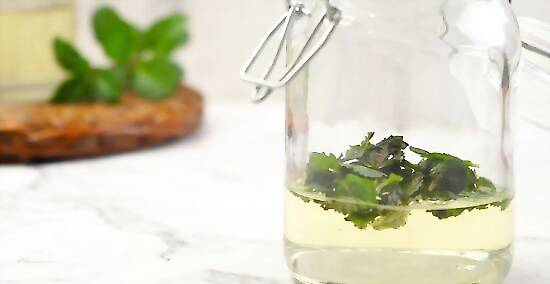
Muddle a new batch of peppermint leaves and add them to your oil. Prepare your second bunch of leaves the same way you did the first, using just enough pressure to break the outer surface and free the oils inside. Avoid grinding or tearing the leaves into too-small pieces.
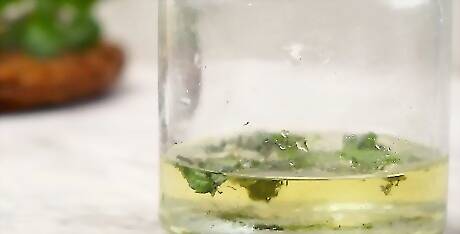
Continue steeping and straining to increase your oil's potency. Repeat the initial steps as many times as needed to until your oil reaches the desired strength. This will usually take somewhere from 2-3 days, though you could keep adding new leaves for up to a week. With each round of steeping and straining, you’ll notice your peppermint oil growing darker in color and giving off a stronger aroma. You may not be able to tell much of a difference in the concentration of your oil after about a week.
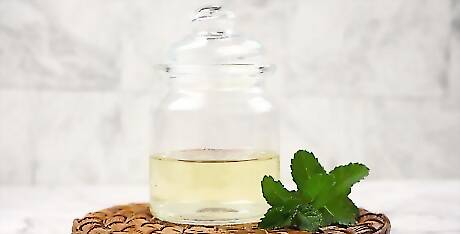
Seal the jar and store your peppermint oil for up to 3-6 months. Once sealed, the jar will help preserve the freshness of your oil until you’re ready to use it. To maximize your oil’s longevity, keep it in a cool, dark place at or slightly below room temperature, and be sure to reseal the jar promptly after each use. The shelf life of homemade peppermint oil may vary depending on the exact quantity produced and the amount of plant material left behind. If you notice your peppermint oil developing a strange color or odor after a few months, it’s best to throw it out and whip up a new batch.



















Comments
0 comment